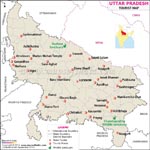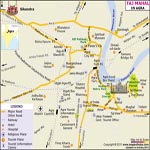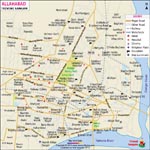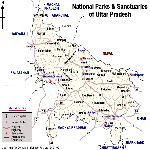Places to See in Uttar Pradesh
Talking about Uttar Pradesh tourist destinations, one can talk elaborately on the picturesque sites of the Himalayan foot-hills! Uttar Pradesh tourist destinations, set amid the beautiful landscape of the Himalayas, is indeed, a delight to the tourists!
Agra
Taj Mahal, Red Fort and Fatehpur Sikri make Agra one of most sought-after destinations in the world. Agra is known for its culture, art, and religious philosophies that have enriched human thought over centuries.Agra houses one of the seven wonders of the world - Taj Mahal. More Details...
How to Reach Agra
By Air
Agra is connected to Delhi, Khajuraho and Varanasi by Indian Airlines. Kheria Airport is located at a distance of about 9 kilometer from Government of India Tourist Office.
By Rail
Agra is a prominent railway junction on main rail routes to the south, east, and west. Shatabdi Express (between Delhi and Bhopal) and Taj Express (between Delhi and Gwalior) make Agra easily accessible.
By Road
A few important road distances from Agra are Bharatpur - 54 kilometer., Delhi - 204 kilometer, and Gwalior - 119 kilometer.
Travel Maps
Taj Mahal
Mughal Emperor Shah Jahan built Taj Mahal as a memento of his favorite Queen, Mumtaz. It was completed in 1653 AD. It is one of India's most beautiful monuments.
Sikandra Fort
It reflects the philosophy and secular outlook of Akbar in its blend of the best of Hindu and Muslim architecture. It was completed by his son Jahangir in 1613 AD.
Agra Fort
Mughal Emperor Akbar started the construction of this fort in 1565 AD though it was finally completed during the time of his grandson Shah Jahan.
Itmad-Ud-Daulah
It is the tomb of Mirza Ghyas Beg, a Persian who served in Akbar's Court. The tomb was built by Emperor Jahangir's Queen, Noorjahan during 1622-1628 AD.
Radha Swami Samadhi
The holy ashes of the founder of Radhaswami religion are preserved here. There is a beautiful temple in the premises.
Allahabad
According to Hindu mythology, Allahabad was given the status of the king of all pilgrimage center by Lord Brahma, the creator god.
Allahabad forms one of the famous Uttar Pradesh tourist destinations. Places to visit in Allahabad are:
- Sangam
- Allahabad Fort
- Khusrau Bagh
- Allahabad Musuem
- Anand Bhawan
- Swaraj Bhawan
- Univeristy of Allahabad More Details...
How to Reach Allahabad
By Air
The near airports are located at Varanasi (147 kilometer) and Lucknow (210 kilometer).
By Train
Important cities like Kolkata, Delhi, Patna, Guwahati, Chennai, Mumbai, Gwalior, Meerut, Lucknow, Kanpur, and Varanasi have direct rail connections with Allahabad.
By Road
Allahabad is situated on National Highways 2 and 27. Agra - 433 kilometer, Kanpur - 200 kilometer, and Ahmedabad - 1207 kilometer.
Tourist Attractions in Allahabad
Sangam
Here the three holy rivers Ganga, Yamuna, and Saraswati merge into one. During the Kumbh Mela and the Ardh Kumbh, it comes alive with millions of devotees from all over the country.
Allahabad Fort
Emperor Akbar built this lofty fort in 1583 AD on the bank of river Yamuna. A polished sandstone Ashokan pillar as old as 232 BC stands inside the fort.
All Saints Cathedral
It is perhaps the finest Anglican cathedral in Asia. It is dedicated to the memory of all those people who have faith in God. It is a specimen of 13th century Gothic architectural style. It was designed by Sir William Emerson and reflects colonial architecture.
Hanuman Temple
The Hanuman Temple is located near Sangam. It has the largest image of Lord Hanuman.
Jawahar Planetarium
It offers a celestial trip. A moon model is displayed in the planetarium.
Varanasi
Varanasi is an old living city of the world. Buddhist scriptures as well as the epic Mahabharata contains one of the earliest descriptions of Varanasi. Its connection with myths, legends and religion attracts a large number of pilgrims from all over the world.Varanasi's prominence in Hindu mythology is unquestionable. More Details...
Varanasi, aka Benaras, is the vital part of Uttar Pradesh tourist destinations. The major locations in Varanasi that is worth seeing are:
- Ghats
- Sarnath
- Ramnagar
- Ashokan Pillars
How to Reach Varanasi
By Air
Maharaja Banaras Vidya Mandir Museum
Maharaja Balwant Singh (1740-70 AD) originally built Ramnager fort. The Banaras Vidya Mandir Museum is situated in the Ramnager fort. The museum collection includes textiles, pieces of decorative arts, old palkis, furniture and manuscripts.
Deogarh
Deogarh that is situated in the present Lalitpur district of Uttar Pradesh.Deogarh is epigraphically and archaeologically a very importance site of Uttar Pradesh. The name of Deogarh of Uttar Pradesh is mentioned many times in the chronicles of Indian history. Deogarh is a witness to many important events in Indian history.Deogarh of Uttar Pradesh has found mentioned during the reign of the Guptas, Gonds, and during Muslim rule in Delhi.Deogarh in Uttar Pradesh was also important during British raj.
The Dashavatar Temple of Deogarh, Uttar Pradesh is a beautiful Vishnu temple of the Gupta period. This hindu temple of Deogarh at Uttar Pradesh was previously known as the Panchayatan temples of north India and called the 'Jewel of Deogarh'. The temple is popular for its Rathika Panels and noted for being the first temple of India with a Shikara or Spire.
Apart from the Dashavatar Temple, Deogarh in Uttar Pradesh is also a famous Jain Center of India. Today, Deogarh, Uttar Pradesh, boasts for being the home to nearly 31 remarkable ancient Jain temples.
The panels inside these Jain temples depict panoramas of Jain mythology, images of the Tirthankaras, votive pillars and votive tablets carved on the walls of the temple. This site of Deogarh at Uttar Pradesh, remained as the famous Jain center from the 6th to the 17th century. These temples are situated on the Deogarh fort.
The Deogarh Archaeological Museum has the finest collection of ancient art and sculpture retrieved from the neighboring sites of Deogarh, Uttar Pradesh.
Kalinjar
Kalinjar town and fort was of strategic importance during medieval times. It is located in an integral part of Bundelkhand, called Jejakbhukti. From the 9th to the 15th centuries, the Kalinjar fort was a Chandela stronghold and did not lose its importance upto the time of the Mughals.
Finally, Akbar conquered it in 1569 and gifted it to one of the "nine jewels" of his court, Birbal. Later, it went to the legendary Bundela warrior, Chhatrasal and Hardev Shah of Panna, before being sieged by the British in 1812.
Kalinjar Fort
This fort is situated on the Vindhya ranges at a height of 700 feet. This fort is accessible by seven gateways, namely Alamgir Darwaza, Ganesh Dwar, Chauburji Darwaza, Buddha Bhadra Darwaza, Hanuman Dwar, Lal Darwaza, and Bara Darwaza. There are two palaces - Raja Mahal and Rani Mahal within the fort. The other prominent parts of the fort are as follows:
- Sita Sej: It is a small cave with a stone bed and pillow, which were once used by hermits.
- Buddha-Budhi taal - Its waters are believed to possess healing qualities.
- Mrigdhara: It is a spring located within an inner chamber of the rampart.
- Koito Birth: It is an important pilgrimage spot, which is believed to cure lepers.
- Neelkanth Temple: This temple was built by Parmardi Dev, the Chandela ruler An eighteen-armed image of Al Bhairav, the fearsome aspect of Lord Shiva is a major attraction of the place.
- Vankhandeshwar Mahadev Temple: This temple of Kalinjar is located at the source of the Shivasari Ganga.
Kapilvastu
Kapilvastu used to be the ancient capital of Sakya clan. The Sakya ruler was the father of Buddha. At the age of 29, Buddha left his palace in Kapilvastu and revisited it 12 years later, after attaining enlightenment. Kapilvastu consists of several villages including Piprahwa and Ganvaria. A large stupa at Kapilvastu is said to have housed Buddha's bone relics.
Kapilvastu Festivals
Kapilvastu Buddha Mahotsava: The Uttar Pradesh Tourism Department organises this festival from 29 December to 31 December.
Kartik Poornima/Srawan Mela
Magh Mela
It starts with Makar Sankranti and ends with Maha Shivratri. Magh Mela can be termed the annual version of the Kumbh Mela. It takes place at Sangam in Allahabad. This time is regarded auspicious for taking holy dips in the Sangam.
Navratri
The festival of Dassera is one of the most famous festivals of India. This festival is celebrated in September or October. On the first nine nights, goddess Durga is worshipped and therefore, these nights are known as "Navaratri". The tenth day of the Dassera is dedicated to Durga Devi.
Tourist Attractions of Kapilvastu
Stupa Complex
This archaeological site was discovered during the 1973-74 excavations. The seals and inscriptions over the lid of a pot excavated here refers to Kanishka, a great patron of Buddhism.
Palace Site
Dr. K.M. Srivastava excavated the ruins of the palace of King Shuddhodhan, the father of Lord Buddha. Lord Buddha is said to have spent the first 29 years of his life here.
Mathura
Mathura is famous as the birth place of lord Krishna. It is located on the western bank of river Yamuna. It is located at a distance of 145 kilometer to the south-east of Delhi and 58 kilometer to the north-west of Agra. It is equally treasured by the Buddhists, the Jains and the Brahmans. Today, Mathura stands as a place of enormous religious and historic interest. More Details...
How to Reach Mathura
By Air
The nearest airport is Kheria (Agra) - 62 kilometer
By Rail
Mathura is located on the main lines of Central and Western Railways. It is connected with all the important cities of the state such as Gwalior, Calcutta, Delhi, Agra, Mumbai, and Lucknow.
By Road
National Highways connect Mathura to all the major cities of India. State bus services of Uttar Pradesh, Madhya Pradesh, Rajasthan and Haryana connects it with the rest of India.
Local Means of Transport : Private buses, tempos, and rickshaws.
Tourist Attractions in Mathura
Shri Krishna Janma Bhumi
It is Lord Krishna's birth place.
Vishram Ghat
Lord Krishna is believed to have rested here after slaying Kansa.
Gita Mandir
The carving and painting of the temple are its chief attractions. It is situated on the outskirts of the city.
Dwarkadheesh Temple
It is the most prominent temple in the town. During Holi, Janmashthami and Diwali, it is decorated elaborately.
Jama Masjid
Abo-in-Nabir-Khan built it in 1661 AD. It has four lofty minarets with bright colored mosaic of which a few panels currently exist.
Government Museum
It is an archaeological treasure in Mathura with rare items from the Gupta and Kushan period (400 BC-1200AD). It is located at Dampier Park.
Kannauj
The city of Kannauj is situated about 80 kilometers from Kanpur of Uttar Pradesh.Kannauj in Uttar Pradesh is a historical town by the banks of the holy Ganga river. Kannauj in Uttar Pradesh enjoyed a dominating place in the ancient and medieval period of Indian History. During the reign of the celebrated ruler, Harshavardhana in the 7th century, Kannauj was turned to be the capital city of his kingdom.
According to the 2001 census, the city of Kannauj has an approximate population of about 71,530. The average literacy rate of Kannauj is about 58%. The most popular tourists destination in around Kannauj at Uttar Pradesh are as follows:
- Lakh Bahosi Bird Sanctuary
- Annapurna Temple
- Kannauj Museum
- Gauri Shankar Temple
- Dargah of Haji Sharif
The ancient temples of Gauri Shankar, Annapurna and the Dargah of Haji Sharif in Kannauj in Uttar Pradesh are still some of the major religious places of worship from the past and they attract thousands of devout who come and pay their homage to the deities.
Vrindavan
Vrindavan is located at a distance of 15 kilometer to the north of Mathura on the bank of Yamuna. To a devout Hindu, Vrindavan holds as much importance as Mathura. The place is closely associated with Krishna. The temple site of India, Vrindavan, houses some of the most renowned temples of India.
Temples in Vrindavan
Krishna Balram Mandir
This is an international spiritual organization. It has 400 centers across the world. Thousands of pilgrims and tourists visit this temple from all over the world.
Govinda Dev Temple
Raja Man Singh of Jaipur built it in 1590. The temple is an exemplary work of architecture of medieval India. The temple walls have an average thickness of 10 feet.. It was originally seven-storied, but its upper four stories were destroyed during the time of Aurangzeb.
Rangji Temple
It is the longest temple of Vrindavan. It was constructed in 1851 by Seth Govind Das and Seth Laxmi Chand. The temple is a specimen of South Indian architectural pattern.
Shahji Temple
It is one of the most important temples of northern India. In the year 1860, this temple was constructed. Its marvelous architecture, sculpture and twelve marble spiral columns make it stand out.
Radha Ballabh Temple
It is a remnant of ancient Hindu architecture. It was built in 1626. The Shrine was demolished in the 17th century..
Gopi Nath Temple
Its style closely resembles the Madan Mohan Mandir. Rai Shilji, a Sekhavat Rajput of Jaipur built this temple.
Glass Temple
Its dazzling glass work makes it unique.
Madan Mohan Temple
Kapur Ram Das of Multan is believed to have built it. It is situated near Kali Ghat in Vrindavan. During the rein of Aurangzeb, the original image of Madan Mohan was removed to Karauli.
Kushinagar
Kushinagar is one of the principal centres of Buddhist pilgrimage. The three distinct groups of monuments of Kushinagar are: the main site of the Nirvana Temple, the central stupa and surrounding monasteries, the Mathakuar shrine to the south-west, and the Ramabhar Stupa. It is here that Lord Buddha left his corporeal self and attained Mahaparinirvana.
Kushinagar Festivals
Buddh Poornima
Buddha Poornima, held on the full moon night of either April or May, commemorates the birth anniversary of the founder of Buddhism, Lord Buddha.
Tourist Attractions of Kushinagar
Nirvana Stupa
This huge stupa made of brick was exposed by Carlyl in 1876. It is 2.74 meter high. An inscription on a copper vessel unearthed at this site states that Lord Buddha's remains are deposited here.
Nirvana Temple
Mathakuar Shrine
This shrine lies at a distance of about 400 yards from the Parinirvana stupa. An image of Buddha in black stone was recovered here. Lord Buddha gave his last sermon here.
Ramabhar Stupa
It is a large stupa, which rises to a height of 49 feet about 1 kilometer away from Mathakuar Shrine. Lord Buddha was cremated here. This stupa has been referred to as Mukut-Bandhan Vihar in ancient Buddhist texts.
Chinese Temple
A beautiful statue of Lord Buddha is the major attraction of this place.
Japanese Temple
A beautiful statue of Lord Buddha, which is made of eight metals and originally belonged to Japan is housed in this temple of Kushinagar.
Last Updated on : May 30, 2015




